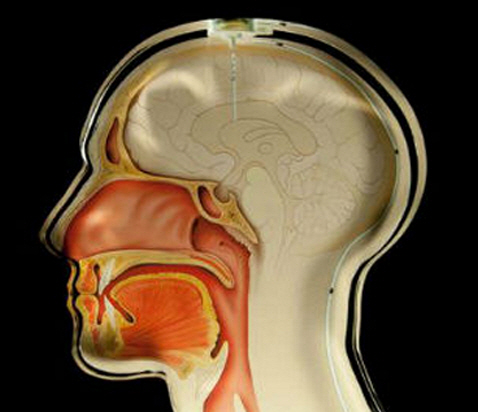In the last few days alone we've read about a smart contact lens for diabetics and about the magic of silver nanowires in creating healthcare wearable technology of the extremely useful kind. Well, today we can also add accurate embedded cerebral pressure monitors to the mix.
Researchers at the Fraunhofer Institute for Microelectronic Circuits and Systems IMS in Duisburg, Germany, working jointly with teams from Christoph Miethke GmbH and Aesculap AG, have developed sensor technology that is able to do exactly this. Once such a sensor is embedded, doctors and other healthcare providers will be able to quickly and accurately measure cerebral pressure simply by using a hand-held reader on the head of the patient where the sensor is located.
Of course, simply (well, perhaps not so simply) being able to measure cerebral pressure is all well and good, but doctors would also need to have ways to increase or decrease pressure in order for the pressure sensor to have the greatest possible value. As it turns out, such a capability also exists. A shunt system, a silicon tube that physicians implant into the patient’s brain, provides relief. The system draws off excess fluid from there as needed. The heart of system is a valve: If the pressure increases above a threshold value, then the valve opens. As proper pressure is restored the valve closes.
With the new sensor, doctors can now implant a system directly within the head that can in fact directly guide regulating cerebral pressure through the shunt system described above. The pressure sensor provides accurate readings to caregivers but can also, if necessary - and perhaps more importantly - constantly measure cerebral pressure in real time and provide brain pressure adjustment readings ongoing as needed.
The sensor system that has been developed is already approved for use as a long-term implant in Europe. The sensor is ready for serial production and Miethke has already initiated the market launch of the system.

Image courtesy of Patrick J. Lynch/Fraunhofer IMS]]
Michael Görtz, head of pressure sensor technology at IMS says that, “The sensor is an active implant, which also takes over measurement functions."
The hand-held meter a caregiver would use is designed to emit magnetic radio waves, which in turn supplies the embedded sensor with power. Once turned on the sensor then measures temperature and pressure in the cerebral fluid and transmits its data directly back to the handheld device. A physician can then set a valve from outside to the embedded pressure system as needed and indicated, and can individually adjust and fine tune as a patient may require.
Such implants must also necessarily be biocompatible - that is, the body cannot reject them. Researchers have also had to ensure that the body will not attack the implant. Miethke therefore completely encases the implant into a thin metal casing. To do so, the correct metal had to be found applied with a thickness much thinner than one millimeter. The research teams also developed the handheld reading device and its electronics.
Görtz notes that, “The body's defense response behaves just like an aggressive medium, that would even dilute the silicon of the electronics over the course of time. Our system allows us to supply the sensor with power from the outside through the metal casing, measure cerebral pressure and transmit the recorded data back through the metal to the reader.”
Finally, Görtz adds, “The sensor sets the basis for further development through to theranostic implants. Theranostic is a word we've coined that is derived from the words 'therapy' and 'diagnostic.' Within a few years we anticipate that the sensor will not only record cerebral pressure and develop a diagnosis on the basis of this, but will also be able to properly adjust the pressure independently, immediately on its own and - we hope - will be able to take over most of the therapy process."
The new sensor is yet another demonstration of how wearable technology is manifesting itself within the healthcare and medical industry. We look forward to it finding its way across the pond to the United States at some point in the near future.
Edited by
Cassandra Tucker